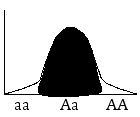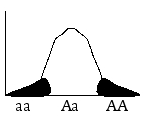Essay
Three types of selection are "directional selection," "balancing selection," and "selection against heterozygotes."
a)Shown below are three graphs (A-C).Each graph represents a different type of selection.In each case,certain individuals are being selected against (represented by the striped regions).For each graph,write the name of the type of selection that is depicted.
A)
B)
C)
b)Described below are three examples of selection.For each example,write the name of the type of selection being described.
i)A maize breeder selects for increased ear size in maize in order to increase yield.
ii)Susceptibility to malaria and sickle-cell anemia is controlled by the same gene.The HbA allele provides resistance to sickle-cell anemia but not to malaria (thus,individuals who have the genotype HbAHbA die from malaria),and the HbS allele provides resistance to malaria but not to sickle-cell anemia (thus,individuals with the genotype HbSHbS die from sickle-cell anemia).HbAHbS individuals are resistant to both diseases.
iii)Lower-yielding beans are resistant to anthracnose,whereas higher-yielding varieties are susceptible to the disease.Anthracnose is present only in certain areas of the region.So,breeders want to select higher- and lower-yielding plants to fulfill different breeding goals.
Correct Answer:

Verified
a)A = selection against hetero...View Answer
Unlock this answer now
Get Access to more Verified Answers free of charge
Correct Answer:
Verified
View Answer
Unlock this answer now
Get Access to more Verified Answers free of charge
Q14: When considering synonymous and nonsynonymous mutations within
Q15: The gene for which of the following
Q16: In E.coli,the mutation of beta-lactamase in response
Q17: Why do you expect different rates of
Q18: The neutral theory of evolution proposed that
Q20: How will pleiotropy affect selection at particular
Q21: An excess of nonsynonymous fixed mutations between
Q22: Which researcher proposed that change was caused
Q23: Suppose that you have cloned and sequenced
Q24: Define the molecular clock.